Analyzing Health Interventions: East London Diabetes (NS4004)
VerifiedAdded on 2022/09/18
|11
|3160
|25
Essay
AI Summary
This essay investigates the most significant health interventions in East London, with a particular focus on addressing the public health issue of diabetes. The essay begins by highlighting the prevalence of diabetes, particularly type 2, within the UK and specifically in East London, noting the higher risk among ethnic minority populations. It then discusses key national and international public health policies and drivers, such as the NHS Health Check program and the influence of ethnicity. The core of the essay analyzes the 'Healthier You' NHS Diabetes Prevention Programme, detailing its objectives, implementation, and the activities involved in helping individuals manage their risk factors through lifestyle changes. A comparison is made with other diabetes prevention programs like 'Flo and Skype', and the importance of the 'Healthier You' program is emphasized, highlighting its potential to reduce financial burdens and improve the overall well-being of the population in East London. The essay concludes by asserting the program's effectiveness in achieving its goals and its significance in improving the lives of individuals at high risk.
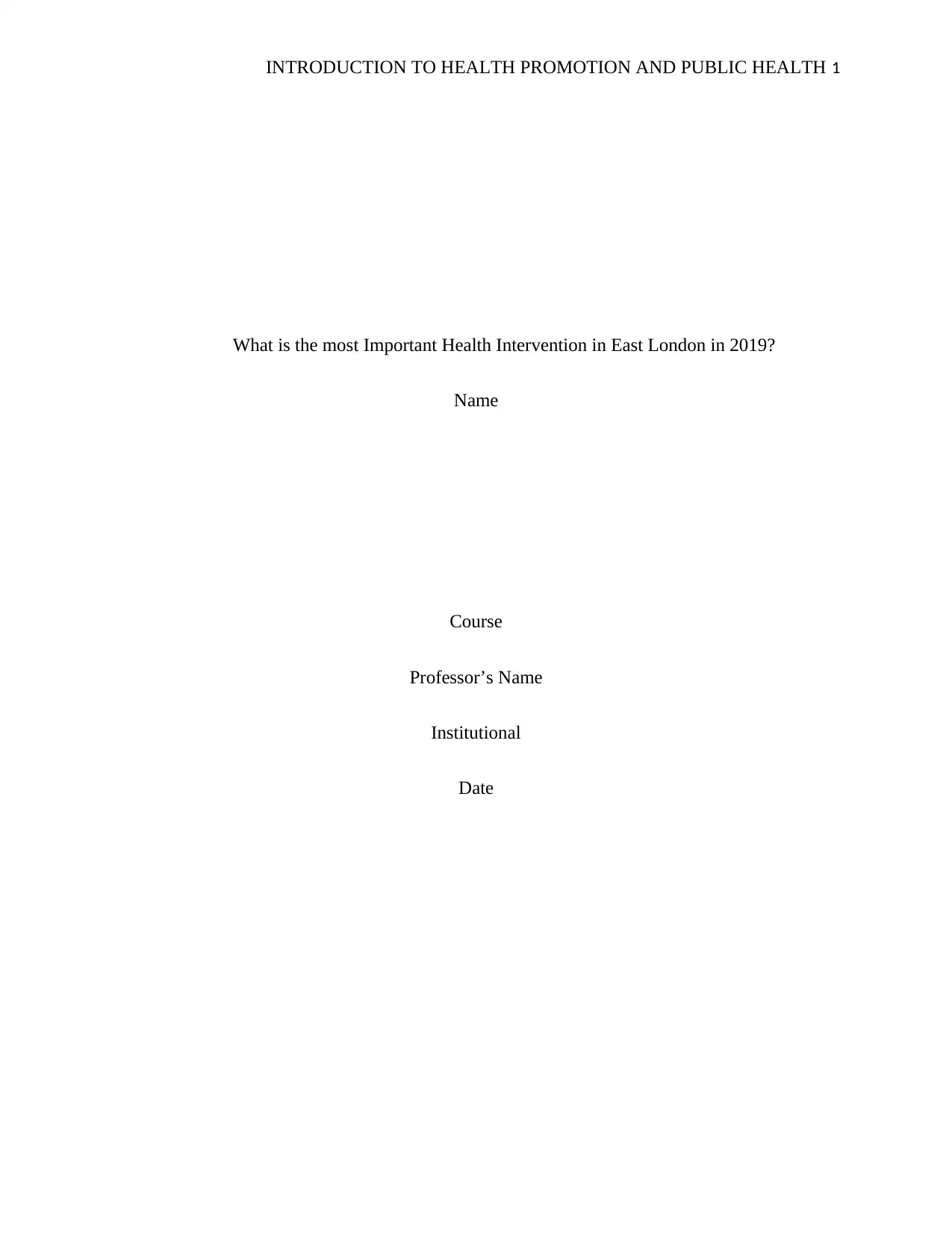
INTRODUCTION TO HEALTH PROMOTION AND PUBLIC HEALTH 1
What is the most Important Health Intervention in East London in 2019?
Name
Course
Professor’s Name
Institutional
Date
What is the most Important Health Intervention in East London in 2019?
Name
Course
Professor’s Name
Institutional
Date
Paraphrase This Document
Need a fresh take? Get an instant paraphrase of this document with our AI Paraphraser
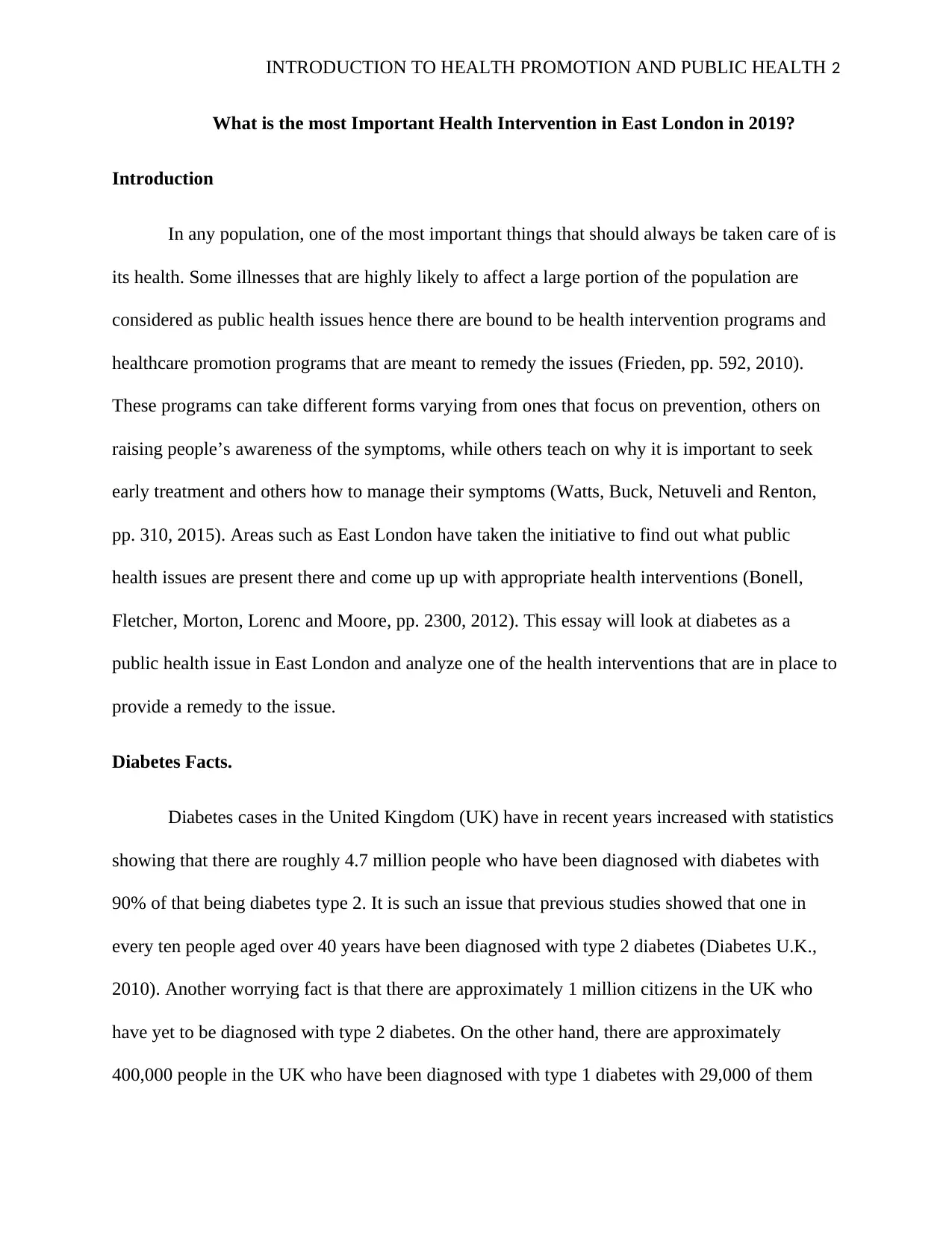
INTRODUCTION TO HEALTH PROMOTION AND PUBLIC HEALTH 2
What is the most Important Health Intervention in East London in 2019?
Introduction
In any population, one of the most important things that should always be taken care of is
its health. Some illnesses that are highly likely to affect a large portion of the population are
considered as public health issues hence there are bound to be health intervention programs and
healthcare promotion programs that are meant to remedy the issues (Frieden, pp. 592, 2010).
These programs can take different forms varying from ones that focus on prevention, others on
raising people’s awareness of the symptoms, while others teach on why it is important to seek
early treatment and others how to manage their symptoms (Watts, Buck, Netuveli and Renton,
pp. 310, 2015). Areas such as East London have taken the initiative to find out what public
health issues are present there and come up up with appropriate health interventions (Bonell,
Fletcher, Morton, Lorenc and Moore, pp. 2300, 2012). This essay will look at diabetes as a
public health issue in East London and analyze one of the health interventions that are in place to
provide a remedy to the issue.
Diabetes Facts.
Diabetes cases in the United Kingdom (UK) have in recent years increased with statistics
showing that there are roughly 4.7 million people who have been diagnosed with diabetes with
90% of that being diabetes type 2. It is such an issue that previous studies showed that one in
every ten people aged over 40 years have been diagnosed with type 2 diabetes (Diabetes U.K.,
2010). Another worrying fact is that there are approximately 1 million citizens in the UK who
have yet to be diagnosed with type 2 diabetes. On the other hand, there are approximately
400,000 people in the UK who have been diagnosed with type 1 diabetes with 29,000 of them
What is the most Important Health Intervention in East London in 2019?
Introduction
In any population, one of the most important things that should always be taken care of is
its health. Some illnesses that are highly likely to affect a large portion of the population are
considered as public health issues hence there are bound to be health intervention programs and
healthcare promotion programs that are meant to remedy the issues (Frieden, pp. 592, 2010).
These programs can take different forms varying from ones that focus on prevention, others on
raising people’s awareness of the symptoms, while others teach on why it is important to seek
early treatment and others how to manage their symptoms (Watts, Buck, Netuveli and Renton,
pp. 310, 2015). Areas such as East London have taken the initiative to find out what public
health issues are present there and come up up with appropriate health interventions (Bonell,
Fletcher, Morton, Lorenc and Moore, pp. 2300, 2012). This essay will look at diabetes as a
public health issue in East London and analyze one of the health interventions that are in place to
provide a remedy to the issue.
Diabetes Facts.
Diabetes cases in the United Kingdom (UK) have in recent years increased with statistics
showing that there are roughly 4.7 million people who have been diagnosed with diabetes with
90% of that being diabetes type 2. It is such an issue that previous studies showed that one in
every ten people aged over 40 years have been diagnosed with type 2 diabetes (Diabetes U.K.,
2010). Another worrying fact is that there are approximately 1 million citizens in the UK who
have yet to be diagnosed with type 2 diabetes. On the other hand, there are approximately
400,000 people in the UK who have been diagnosed with type 1 diabetes with 29,000 of them
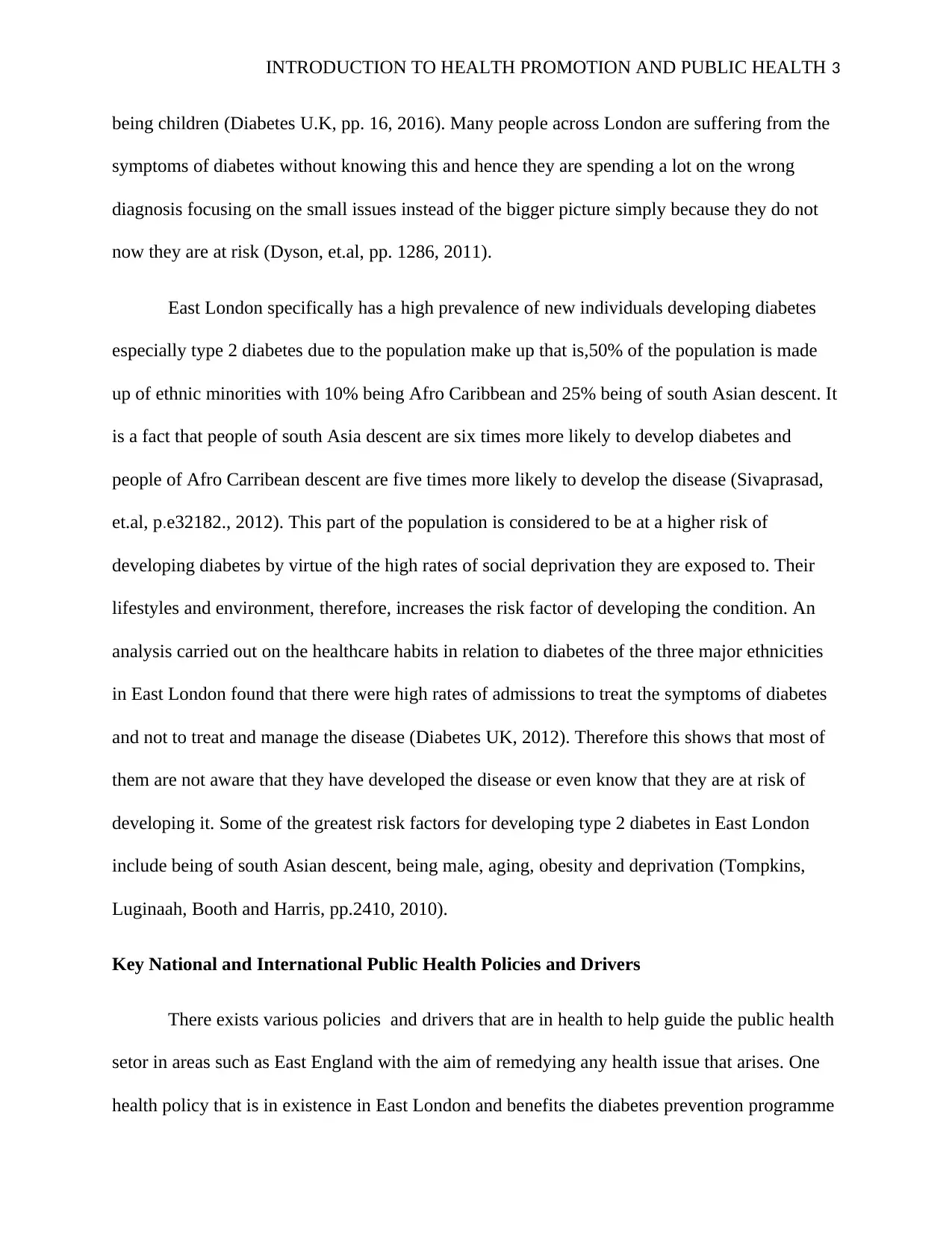
INTRODUCTION TO HEALTH PROMOTION AND PUBLIC HEALTH 3
being children (Diabetes U.K, pp. 16, 2016). Many people across London are suffering from the
symptoms of diabetes without knowing this and hence they are spending a lot on the wrong
diagnosis focusing on the small issues instead of the bigger picture simply because they do not
now they are at risk (Dyson, et.al, pp. 1286, 2011).
East London specifically has a high prevalence of new individuals developing diabetes
especially type 2 diabetes due to the population make up that is,50% of the population is made
up of ethnic minorities with 10% being Afro Caribbean and 25% being of south Asian descent. It
is a fact that people of south Asia descent are six times more likely to develop diabetes and
people of Afro Carribean descent are five times more likely to develop the disease (Sivaprasad,
et.al, p.e32182., 2012). This part of the population is considered to be at a higher risk of
developing diabetes by virtue of the high rates of social deprivation they are exposed to. Their
lifestyles and environment, therefore, increases the risk factor of developing the condition. An
analysis carried out on the healthcare habits in relation to diabetes of the three major ethnicities
in East London found that there were high rates of admissions to treat the symptoms of diabetes
and not to treat and manage the disease (Diabetes UK, 2012). Therefore this shows that most of
them are not aware that they have developed the disease or even know that they are at risk of
developing it. Some of the greatest risk factors for developing type 2 diabetes in East London
include being of south Asian descent, being male, aging, obesity and deprivation (Tompkins,
Luginaah, Booth and Harris, pp.2410, 2010).
Key National and International Public Health Policies and Drivers
There exists various policies and drivers that are in health to help guide the public health
setor in areas such as East England with the aim of remedying any health issue that arises. One
health policy that is in existence in East London and benefits the diabetes prevention programme
being children (Diabetes U.K, pp. 16, 2016). Many people across London are suffering from the
symptoms of diabetes without knowing this and hence they are spending a lot on the wrong
diagnosis focusing on the small issues instead of the bigger picture simply because they do not
now they are at risk (Dyson, et.al, pp. 1286, 2011).
East London specifically has a high prevalence of new individuals developing diabetes
especially type 2 diabetes due to the population make up that is,50% of the population is made
up of ethnic minorities with 10% being Afro Caribbean and 25% being of south Asian descent. It
is a fact that people of south Asia descent are six times more likely to develop diabetes and
people of Afro Carribean descent are five times more likely to develop the disease (Sivaprasad,
et.al, p.e32182., 2012). This part of the population is considered to be at a higher risk of
developing diabetes by virtue of the high rates of social deprivation they are exposed to. Their
lifestyles and environment, therefore, increases the risk factor of developing the condition. An
analysis carried out on the healthcare habits in relation to diabetes of the three major ethnicities
in East London found that there were high rates of admissions to treat the symptoms of diabetes
and not to treat and manage the disease (Diabetes UK, 2012). Therefore this shows that most of
them are not aware that they have developed the disease or even know that they are at risk of
developing it. Some of the greatest risk factors for developing type 2 diabetes in East London
include being of south Asian descent, being male, aging, obesity and deprivation (Tompkins,
Luginaah, Booth and Harris, pp.2410, 2010).
Key National and International Public Health Policies and Drivers
There exists various policies and drivers that are in health to help guide the public health
setor in areas such as East England with the aim of remedying any health issue that arises. One
health policy that is in existence in East London and benefits the diabetes prevention programme
⊘ This is a preview!⊘
Do you want full access?
Subscribe today to unlock all pages.

Trusted by 1+ million students worldwide
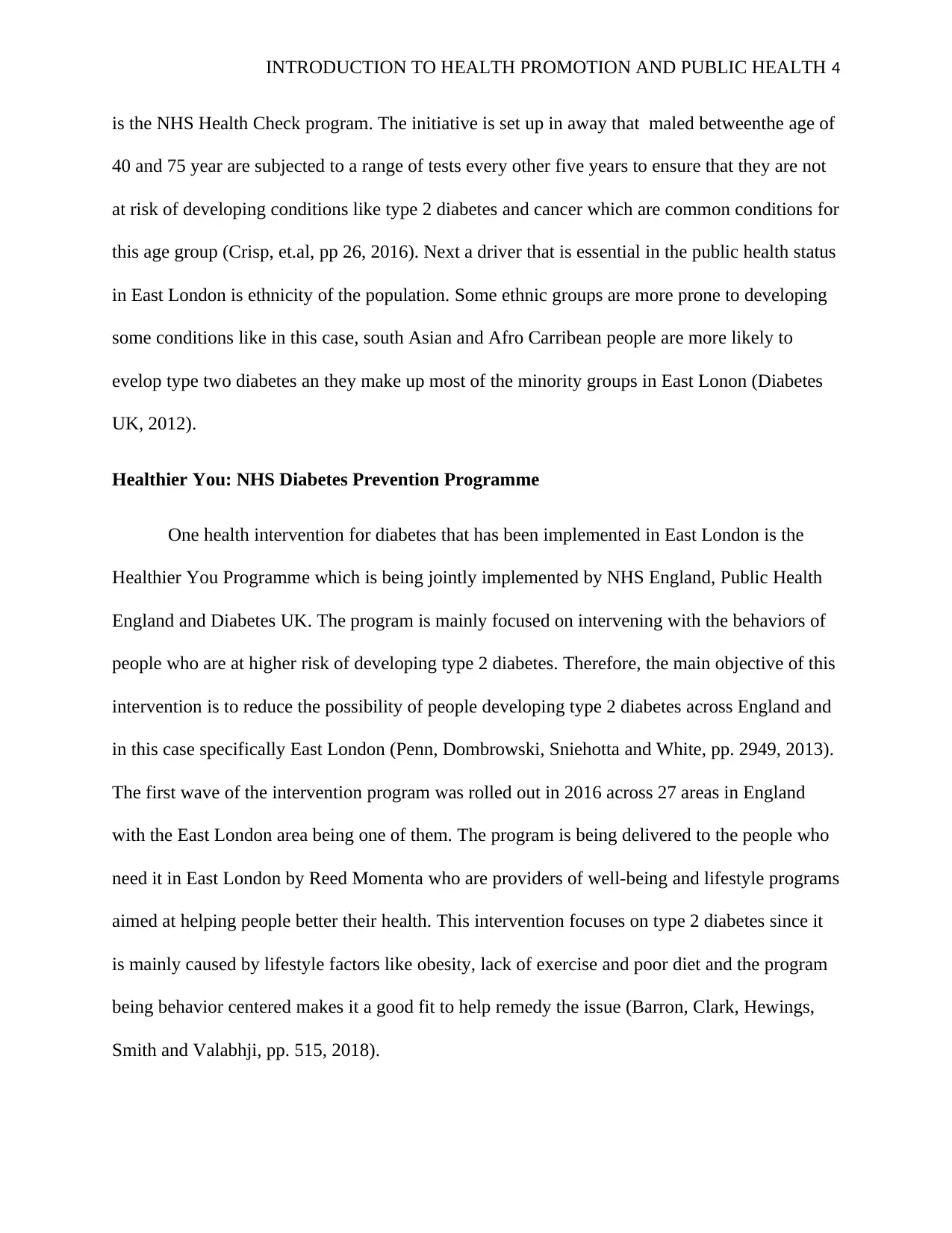
INTRODUCTION TO HEALTH PROMOTION AND PUBLIC HEALTH 4
is the NHS Health Check program. The initiative is set up in away that maled betweenthe age of
40 and 75 year are subjected to a range of tests every other five years to ensure that they are not
at risk of developing conditions like type 2 diabetes and cancer which are common conditions for
this age group (Crisp, et.al, pp 26, 2016). Next a driver that is essential in the public health status
in East London is ethnicity of the population. Some ethnic groups are more prone to developing
some conditions like in this case, south Asian and Afro Carribean people are more likely to
evelop type two diabetes an they make up most of the minority groups in East Lonon (Diabetes
UK, 2012).
Healthier You: NHS Diabetes Prevention Programme
One health intervention for diabetes that has been implemented in East London is the
Healthier You Programme which is being jointly implemented by NHS England, Public Health
England and Diabetes UK. The program is mainly focused on intervening with the behaviors of
people who are at higher risk of developing type 2 diabetes. Therefore, the main objective of this
intervention is to reduce the possibility of people developing type 2 diabetes across England and
in this case specifically East London (Penn, Dombrowski, Sniehotta and White, pp. 2949, 2013).
The first wave of the intervention program was rolled out in 2016 across 27 areas in England
with the East London area being one of them. The program is being delivered to the people who
need it in East London by Reed Momenta who are providers of well-being and lifestyle programs
aimed at helping people better their health. This intervention focuses on type 2 diabetes since it
is mainly caused by lifestyle factors like obesity, lack of exercise and poor diet and the program
being behavior centered makes it a good fit to help remedy the issue (Barron, Clark, Hewings,
Smith and Valabhji, pp. 515, 2018).
is the NHS Health Check program. The initiative is set up in away that maled betweenthe age of
40 and 75 year are subjected to a range of tests every other five years to ensure that they are not
at risk of developing conditions like type 2 diabetes and cancer which are common conditions for
this age group (Crisp, et.al, pp 26, 2016). Next a driver that is essential in the public health status
in East London is ethnicity of the population. Some ethnic groups are more prone to developing
some conditions like in this case, south Asian and Afro Carribean people are more likely to
evelop type two diabetes an they make up most of the minority groups in East Lonon (Diabetes
UK, 2012).
Healthier You: NHS Diabetes Prevention Programme
One health intervention for diabetes that has been implemented in East London is the
Healthier You Programme which is being jointly implemented by NHS England, Public Health
England and Diabetes UK. The program is mainly focused on intervening with the behaviors of
people who are at higher risk of developing type 2 diabetes. Therefore, the main objective of this
intervention is to reduce the possibility of people developing type 2 diabetes across England and
in this case specifically East London (Penn, Dombrowski, Sniehotta and White, pp. 2949, 2013).
The first wave of the intervention program was rolled out in 2016 across 27 areas in England
with the East London area being one of them. The program is being delivered to the people who
need it in East London by Reed Momenta who are providers of well-being and lifestyle programs
aimed at helping people better their health. This intervention focuses on type 2 diabetes since it
is mainly caused by lifestyle factors like obesity, lack of exercise and poor diet and the program
being behavior centered makes it a good fit to help remedy the issue (Barron, Clark, Hewings,
Smith and Valabhji, pp. 515, 2018).
Paraphrase This Document
Need a fresh take? Get an instant paraphrase of this document with our AI Paraphraser
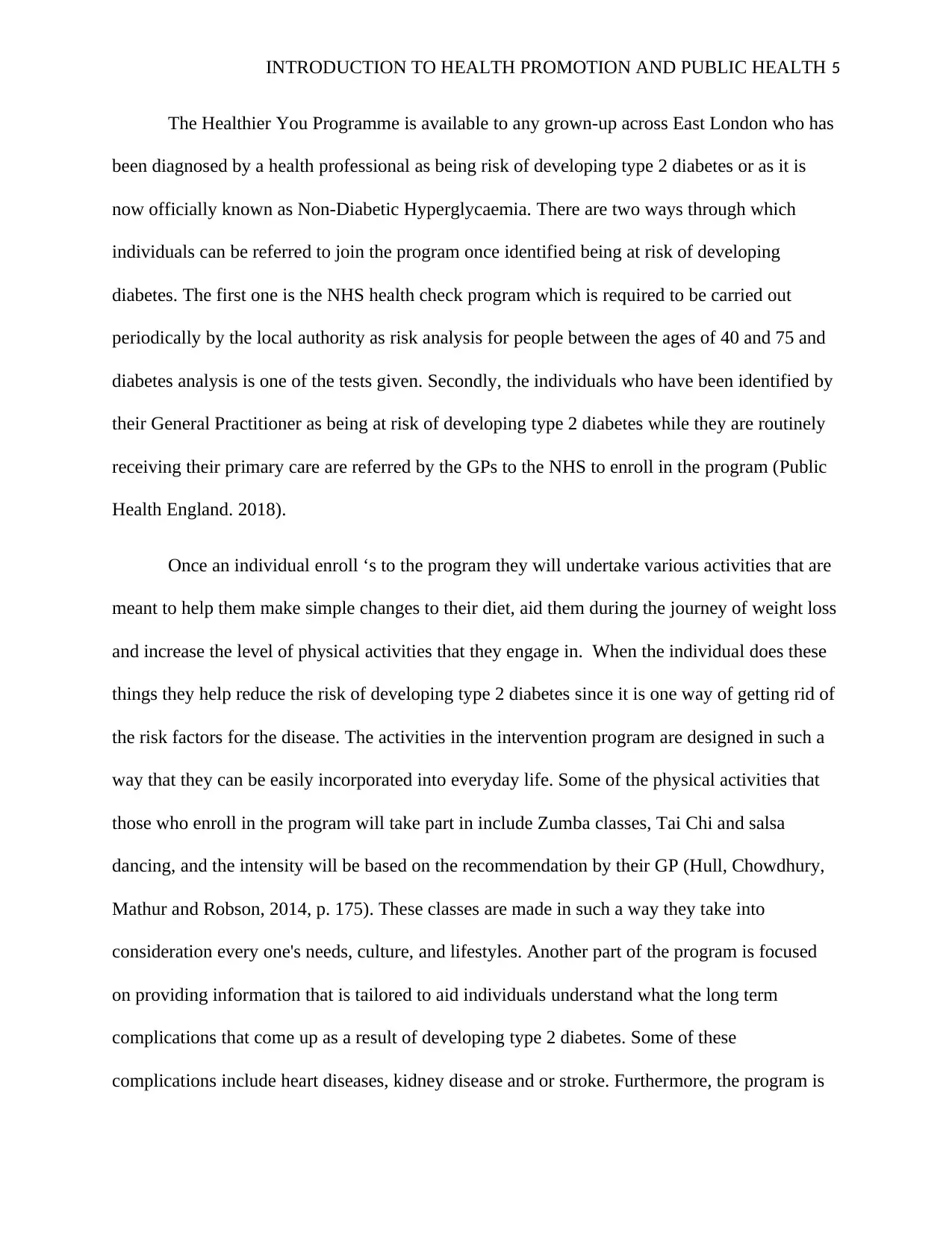
INTRODUCTION TO HEALTH PROMOTION AND PUBLIC HEALTH 5
The Healthier You Programme is available to any grown-up across East London who has
been diagnosed by a health professional as being risk of developing type 2 diabetes or as it is
now officially known as Non-Diabetic Hyperglycaemia. There are two ways through which
individuals can be referred to join the program once identified being at risk of developing
diabetes. The first one is the NHS health check program which is required to be carried out
periodically by the local authority as risk analysis for people between the ages of 40 and 75 and
diabetes analysis is one of the tests given. Secondly, the individuals who have been identified by
their General Practitioner as being at risk of developing type 2 diabetes while they are routinely
receiving their primary care are referred by the GPs to the NHS to enroll in the program (Public
Health England. 2018).
Once an individual enroll ‘s to the program they will undertake various activities that are
meant to help them make simple changes to their diet, aid them during the journey of weight loss
and increase the level of physical activities that they engage in. When the individual does these
things they help reduce the risk of developing type 2 diabetes since it is one way of getting rid of
the risk factors for the disease. The activities in the intervention program are designed in such a
way that they can be easily incorporated into everyday life. Some of the physical activities that
those who enroll in the program will take part in include Zumba classes, Tai Chi and salsa
dancing, and the intensity will be based on the recommendation by their GP (Hull, Chowdhury,
Mathur and Robson, 2014, p. 175). These classes are made in such a way they take into
consideration every one's needs, culture, and lifestyles. Another part of the program is focused
on providing information that is tailored to aid individuals understand what the long term
complications that come up as a result of developing type 2 diabetes. Some of these
complications include heart diseases, kidney disease and or stroke. Furthermore, the program is
The Healthier You Programme is available to any grown-up across East London who has
been diagnosed by a health professional as being risk of developing type 2 diabetes or as it is
now officially known as Non-Diabetic Hyperglycaemia. There are two ways through which
individuals can be referred to join the program once identified being at risk of developing
diabetes. The first one is the NHS health check program which is required to be carried out
periodically by the local authority as risk analysis for people between the ages of 40 and 75 and
diabetes analysis is one of the tests given. Secondly, the individuals who have been identified by
their General Practitioner as being at risk of developing type 2 diabetes while they are routinely
receiving their primary care are referred by the GPs to the NHS to enroll in the program (Public
Health England. 2018).
Once an individual enroll ‘s to the program they will undertake various activities that are
meant to help them make simple changes to their diet, aid them during the journey of weight loss
and increase the level of physical activities that they engage in. When the individual does these
things they help reduce the risk of developing type 2 diabetes since it is one way of getting rid of
the risk factors for the disease. The activities in the intervention program are designed in such a
way that they can be easily incorporated into everyday life. Some of the physical activities that
those who enroll in the program will take part in include Zumba classes, Tai Chi and salsa
dancing, and the intensity will be based on the recommendation by their GP (Hull, Chowdhury,
Mathur and Robson, 2014, p. 175). These classes are made in such a way they take into
consideration every one's needs, culture, and lifestyles. Another part of the program is focused
on providing information that is tailored to aid individuals understand what the long term
complications that come up as a result of developing type 2 diabetes. Some of these
complications include heart diseases, kidney disease and or stroke. Furthermore, the program is
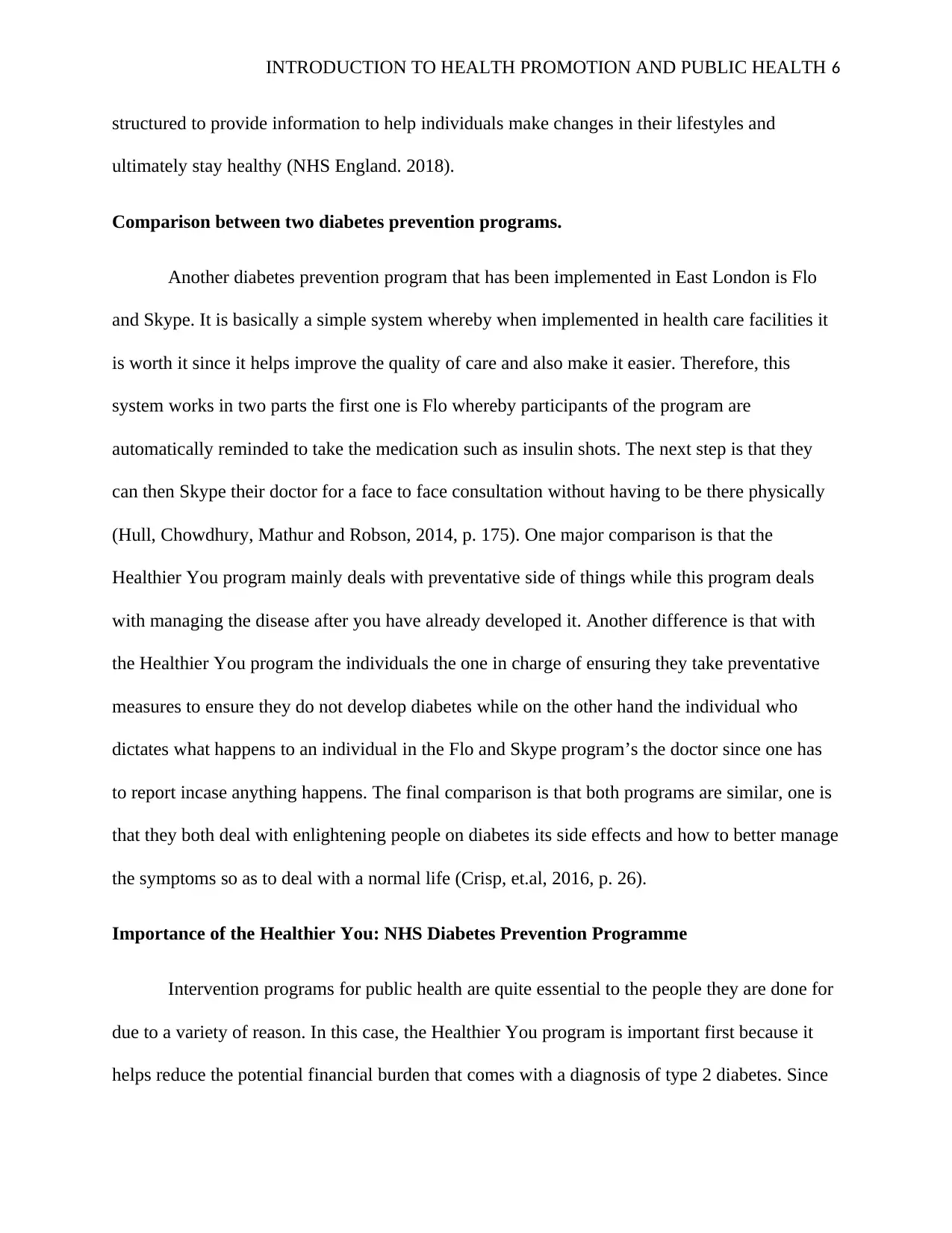
INTRODUCTION TO HEALTH PROMOTION AND PUBLIC HEALTH 6
structured to provide information to help individuals make changes in their lifestyles and
ultimately stay healthy (NHS England. 2018).
Comparison between two diabetes prevention programs.
Another diabetes prevention program that has been implemented in East London is Flo
and Skype. It is basically a simple system whereby when implemented in health care facilities it
is worth it since it helps improve the quality of care and also make it easier. Therefore, this
system works in two parts the first one is Flo whereby participants of the program are
automatically reminded to take the medication such as insulin shots. The next step is that they
can then Skype their doctor for a face to face consultation without having to be there physically
(Hull, Chowdhury, Mathur and Robson, 2014, p. 175). One major comparison is that the
Healthier You program mainly deals with preventative side of things while this program deals
with managing the disease after you have already developed it. Another difference is that with
the Healthier You program the individuals the one in charge of ensuring they take preventative
measures to ensure they do not develop diabetes while on the other hand the individual who
dictates what happens to an individual in the Flo and Skype program’s the doctor since one has
to report incase anything happens. The final comparison is that both programs are similar, one is
that they both deal with enlightening people on diabetes its side effects and how to better manage
the symptoms so as to deal with a normal life (Crisp, et.al, 2016, p. 26).
Importance of the Healthier You: NHS Diabetes Prevention Programme
Intervention programs for public health are quite essential to the people they are done for
due to a variety of reason. In this case, the Healthier You program is important first because it
helps reduce the potential financial burden that comes with a diagnosis of type 2 diabetes. Since
structured to provide information to help individuals make changes in their lifestyles and
ultimately stay healthy (NHS England. 2018).
Comparison between two diabetes prevention programs.
Another diabetes prevention program that has been implemented in East London is Flo
and Skype. It is basically a simple system whereby when implemented in health care facilities it
is worth it since it helps improve the quality of care and also make it easier. Therefore, this
system works in two parts the first one is Flo whereby participants of the program are
automatically reminded to take the medication such as insulin shots. The next step is that they
can then Skype their doctor for a face to face consultation without having to be there physically
(Hull, Chowdhury, Mathur and Robson, 2014, p. 175). One major comparison is that the
Healthier You program mainly deals with preventative side of things while this program deals
with managing the disease after you have already developed it. Another difference is that with
the Healthier You program the individuals the one in charge of ensuring they take preventative
measures to ensure they do not develop diabetes while on the other hand the individual who
dictates what happens to an individual in the Flo and Skype program’s the doctor since one has
to report incase anything happens. The final comparison is that both programs are similar, one is
that they both deal with enlightening people on diabetes its side effects and how to better manage
the symptoms so as to deal with a normal life (Crisp, et.al, 2016, p. 26).
Importance of the Healthier You: NHS Diabetes Prevention Programme
Intervention programs for public health are quite essential to the people they are done for
due to a variety of reason. In this case, the Healthier You program is important first because it
helps reduce the potential financial burden that comes with a diagnosis of type 2 diabetes. Since
⊘ This is a preview!⊘
Do you want full access?
Subscribe today to unlock all pages.

Trusted by 1+ million students worldwide

INTRODUCTION TO HEALTH PROMOTION AND PUBLIC HEALTH 7
the program is focused on preventing the risk of developing the condition or on how to better
manage it which therefore means that they spend way less than they would have to treat the
symptoms of the disease. Statistics show that treatment for type 2 diabetes and other human costs
associated with the diseases account for nine percent of the National Health Service annual
budget which is around 8.8 billion pounds a year (NICE National Institute for Healthcare
Excellence, 2015).
While type 1 diabetes cannot be prevented, type 2 is, therefore, this gives another reason
since the intervention is tailored in a way that focuses on activities which help prevent
individuals from developing diabetes or how to better manage the illness. Such a program is
essential in the current world since the population even in East London have risk factors such
high obesity rates in the population will increase the likelihood of developing type 2 diabetes.
Also, since the population make up of East London is majorly made up of ethnicities that are said
to highly likely develop the condition, such n intervention is essential in the area as a
preventative measure. Therefore, all of this evidence shows that the health intervention program
is effective in achieving the objectives that it has set to out to fulfill. In my opinion it is a good
program and it does a lot to improve the life of an individual not just in terms of preventing or
managing the disease but wholly improving their lives (Crisp, et.al, 2016, p. 26).
The programme is important in East London especially since the majority of the
individuals who live in the area are considered to be at a higher risk of developing type 2
diabetes. Hence rolling out the program in this area will not only help those managing the
program get information it will also benefit those who have signed up for the program. Another
importance is that by doing this it helps people be in charge of your own treatment since the
the program is focused on preventing the risk of developing the condition or on how to better
manage it which therefore means that they spend way less than they would have to treat the
symptoms of the disease. Statistics show that treatment for type 2 diabetes and other human costs
associated with the diseases account for nine percent of the National Health Service annual
budget which is around 8.8 billion pounds a year (NICE National Institute for Healthcare
Excellence, 2015).
While type 1 diabetes cannot be prevented, type 2 is, therefore, this gives another reason
since the intervention is tailored in a way that focuses on activities which help prevent
individuals from developing diabetes or how to better manage the illness. Such a program is
essential in the current world since the population even in East London have risk factors such
high obesity rates in the population will increase the likelihood of developing type 2 diabetes.
Also, since the population make up of East London is majorly made up of ethnicities that are said
to highly likely develop the condition, such n intervention is essential in the area as a
preventative measure. Therefore, all of this evidence shows that the health intervention program
is effective in achieving the objectives that it has set to out to fulfill. In my opinion it is a good
program and it does a lot to improve the life of an individual not just in terms of preventing or
managing the disease but wholly improving their lives (Crisp, et.al, 2016, p. 26).
The programme is important in East London especially since the majority of the
individuals who live in the area are considered to be at a higher risk of developing type 2
diabetes. Hence rolling out the program in this area will not only help those managing the
program get information it will also benefit those who have signed up for the program. Another
importance is that by doing this it helps people be in charge of your own treatment since the
Paraphrase This Document
Need a fresh take? Get an instant paraphrase of this document with our AI Paraphraser

INTRODUCTION TO HEALTH PROMOTION AND PUBLIC HEALTH 8
program is tailored to suit everyone needs hence one can go with a pace they are comfortable
with (Hull, Chowdhury, Mathur and Robson, 2014, p. 175).
Conclusion.
All in all, public health issues affect a large portion of the population either directly or
indirectly but always in a negative way. Hence, this calls for the necessary people in charge a
population’s health to come up with specific health intervention programs for specific health
issues. This essay covered and analyzed diabetes in East London where we found that 50% of the
population is at a higher risk of developing type 2 diabetes which is preventable (Crisp, et.al,
2016, p. 26). It then assessed a health intervention, Healthier You, which is aimed at providing
lifestyle interventions meant to prevent developing or manage type 2 diabetes and it concluded
that the program is efficient in achieving all the goals it has set for itself. Hence this is evidence
to show that such interventions work and local governments should invest more to research to
come up with health intervention programs for health issues in their areas (Hull, Chowdhury,
Mathur and Robson, 2014, p. 175).
program is tailored to suit everyone needs hence one can go with a pace they are comfortable
with (Hull, Chowdhury, Mathur and Robson, 2014, p. 175).
Conclusion.
All in all, public health issues affect a large portion of the population either directly or
indirectly but always in a negative way. Hence, this calls for the necessary people in charge a
population’s health to come up with specific health intervention programs for specific health
issues. This essay covered and analyzed diabetes in East London where we found that 50% of the
population is at a higher risk of developing type 2 diabetes which is preventable (Crisp, et.al,
2016, p. 26). It then assessed a health intervention, Healthier You, which is aimed at providing
lifestyle interventions meant to prevent developing or manage type 2 diabetes and it concluded
that the program is efficient in achieving all the goals it has set for itself. Hence this is evidence
to show that such interventions work and local governments should invest more to research to
come up with health intervention programs for health issues in their areas (Hull, Chowdhury,
Mathur and Robson, 2014, p. 175).
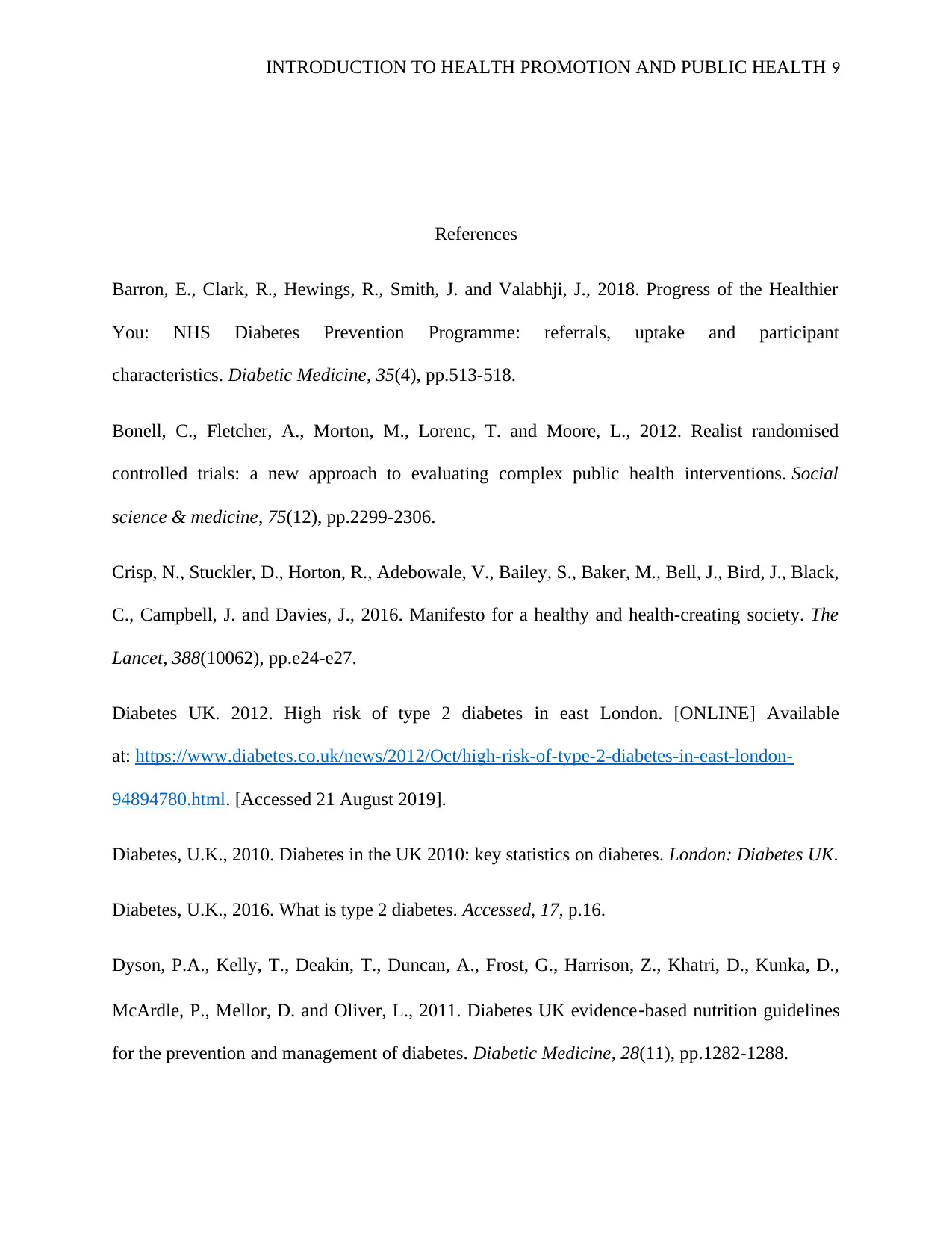
INTRODUCTION TO HEALTH PROMOTION AND PUBLIC HEALTH 9
References
Barron, E., Clark, R., Hewings, R., Smith, J. and Valabhji, J., 2018. Progress of the Healthier
You: NHS Diabetes Prevention Programme: referrals, uptake and participant
characteristics. Diabetic Medicine, 35(4), pp.513-518.
Bonell, C., Fletcher, A., Morton, M., Lorenc, T. and Moore, L., 2012. Realist randomised
controlled trials: a new approach to evaluating complex public health interventions. Social
science & medicine, 75(12), pp.2299-2306.
Crisp, N., Stuckler, D., Horton, R., Adebowale, V., Bailey, S., Baker, M., Bell, J., Bird, J., Black,
C., Campbell, J. and Davies, J., 2016. Manifesto for a healthy and health-creating society. The
Lancet, 388(10062), pp.e24-e27.
Diabetes UK. 2012. High risk of type 2 diabetes in east London. [ONLINE] Available
at: https://www.diabetes.co.uk/news/2012/Oct/high-risk-of-type-2-diabetes-in-east-london-
94894780.html. [Accessed 21 August 2019].
Diabetes, U.K., 2010. Diabetes in the UK 2010: key statistics on diabetes. London: Diabetes UK.
Diabetes, U.K., 2016. What is type 2 diabetes. Accessed, 17, p.16.
Dyson, P.A., Kelly, T., Deakin, T., Duncan, A., Frost, G., Harrison, Z., Khatri, D., Kunka, D.,
McArdle, P., Mellor, D. and Oliver, L., 2011. Diabetes UK evidence‐based nutrition guidelines
for the prevention and management of diabetes. Diabetic Medicine, 28(11), pp.1282-1288.
References
Barron, E., Clark, R., Hewings, R., Smith, J. and Valabhji, J., 2018. Progress of the Healthier
You: NHS Diabetes Prevention Programme: referrals, uptake and participant
characteristics. Diabetic Medicine, 35(4), pp.513-518.
Bonell, C., Fletcher, A., Morton, M., Lorenc, T. and Moore, L., 2012. Realist randomised
controlled trials: a new approach to evaluating complex public health interventions. Social
science & medicine, 75(12), pp.2299-2306.
Crisp, N., Stuckler, D., Horton, R., Adebowale, V., Bailey, S., Baker, M., Bell, J., Bird, J., Black,
C., Campbell, J. and Davies, J., 2016. Manifesto for a healthy and health-creating society. The
Lancet, 388(10062), pp.e24-e27.
Diabetes UK. 2012. High risk of type 2 diabetes in east London. [ONLINE] Available
at: https://www.diabetes.co.uk/news/2012/Oct/high-risk-of-type-2-diabetes-in-east-london-
94894780.html. [Accessed 21 August 2019].
Diabetes, U.K., 2010. Diabetes in the UK 2010: key statistics on diabetes. London: Diabetes UK.
Diabetes, U.K., 2016. What is type 2 diabetes. Accessed, 17, p.16.
Dyson, P.A., Kelly, T., Deakin, T., Duncan, A., Frost, G., Harrison, Z., Khatri, D., Kunka, D.,
McArdle, P., Mellor, D. and Oliver, L., 2011. Diabetes UK evidence‐based nutrition guidelines
for the prevention and management of diabetes. Diabetic Medicine, 28(11), pp.1282-1288.
⊘ This is a preview!⊘
Do you want full access?
Subscribe today to unlock all pages.

Trusted by 1+ million students worldwide
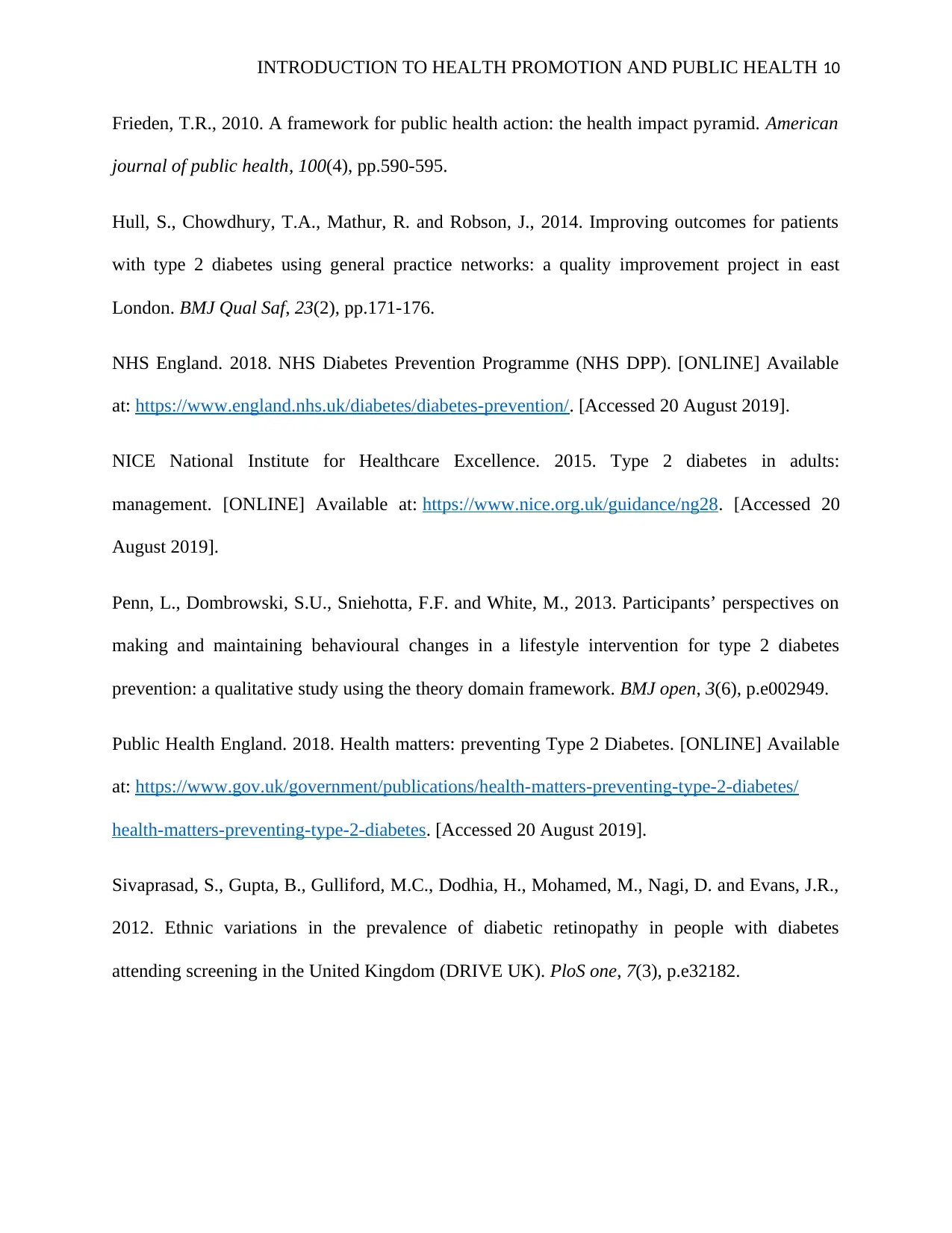
INTRODUCTION TO HEALTH PROMOTION AND PUBLIC HEALTH 10
Frieden, T.R., 2010. A framework for public health action: the health impact pyramid. American
journal of public health, 100(4), pp.590-595.
Hull, S., Chowdhury, T.A., Mathur, R. and Robson, J., 2014. Improving outcomes for patients
with type 2 diabetes using general practice networks: a quality improvement project in east
London. BMJ Qual Saf, 23(2), pp.171-176.
NHS England. 2018. NHS Diabetes Prevention Programme (NHS DPP). [ONLINE] Available
at: https://www.england.nhs.uk/diabetes/diabetes-prevention/. [Accessed 20 August 2019].
NICE National Institute for Healthcare Excellence. 2015. Type 2 diabetes in adults:
management. [ONLINE] Available at: https://www.nice.org.uk/guidance/ng28. [Accessed 20
August 2019].
Penn, L., Dombrowski, S.U., Sniehotta, F.F. and White, M., 2013. Participants’ perspectives on
making and maintaining behavioural changes in a lifestyle intervention for type 2 diabetes
prevention: a qualitative study using the theory domain framework. BMJ open, 3(6), p.e002949.
Public Health England. 2018. Health matters: preventing Type 2 Diabetes. [ONLINE] Available
at: https://www.gov.uk/government/publications/health-matters-preventing-type-2-diabetes/
health-matters-preventing-type-2-diabetes. [Accessed 20 August 2019].
Sivaprasad, S., Gupta, B., Gulliford, M.C., Dodhia, H., Mohamed, M., Nagi, D. and Evans, J.R.,
2012. Ethnic variations in the prevalence of diabetic retinopathy in people with diabetes
attending screening in the United Kingdom (DRIVE UK). PloS one, 7(3), p.e32182.
Frieden, T.R., 2010. A framework for public health action: the health impact pyramid. American
journal of public health, 100(4), pp.590-595.
Hull, S., Chowdhury, T.A., Mathur, R. and Robson, J., 2014. Improving outcomes for patients
with type 2 diabetes using general practice networks: a quality improvement project in east
London. BMJ Qual Saf, 23(2), pp.171-176.
NHS England. 2018. NHS Diabetes Prevention Programme (NHS DPP). [ONLINE] Available
at: https://www.england.nhs.uk/diabetes/diabetes-prevention/. [Accessed 20 August 2019].
NICE National Institute for Healthcare Excellence. 2015. Type 2 diabetes in adults:
management. [ONLINE] Available at: https://www.nice.org.uk/guidance/ng28. [Accessed 20
August 2019].
Penn, L., Dombrowski, S.U., Sniehotta, F.F. and White, M., 2013. Participants’ perspectives on
making and maintaining behavioural changes in a lifestyle intervention for type 2 diabetes
prevention: a qualitative study using the theory domain framework. BMJ open, 3(6), p.e002949.
Public Health England. 2018. Health matters: preventing Type 2 Diabetes. [ONLINE] Available
at: https://www.gov.uk/government/publications/health-matters-preventing-type-2-diabetes/
health-matters-preventing-type-2-diabetes. [Accessed 20 August 2019].
Sivaprasad, S., Gupta, B., Gulliford, M.C., Dodhia, H., Mohamed, M., Nagi, D. and Evans, J.R.,
2012. Ethnic variations in the prevalence of diabetic retinopathy in people with diabetes
attending screening in the United Kingdom (DRIVE UK). PloS one, 7(3), p.e32182.
Paraphrase This Document
Need a fresh take? Get an instant paraphrase of this document with our AI Paraphraser
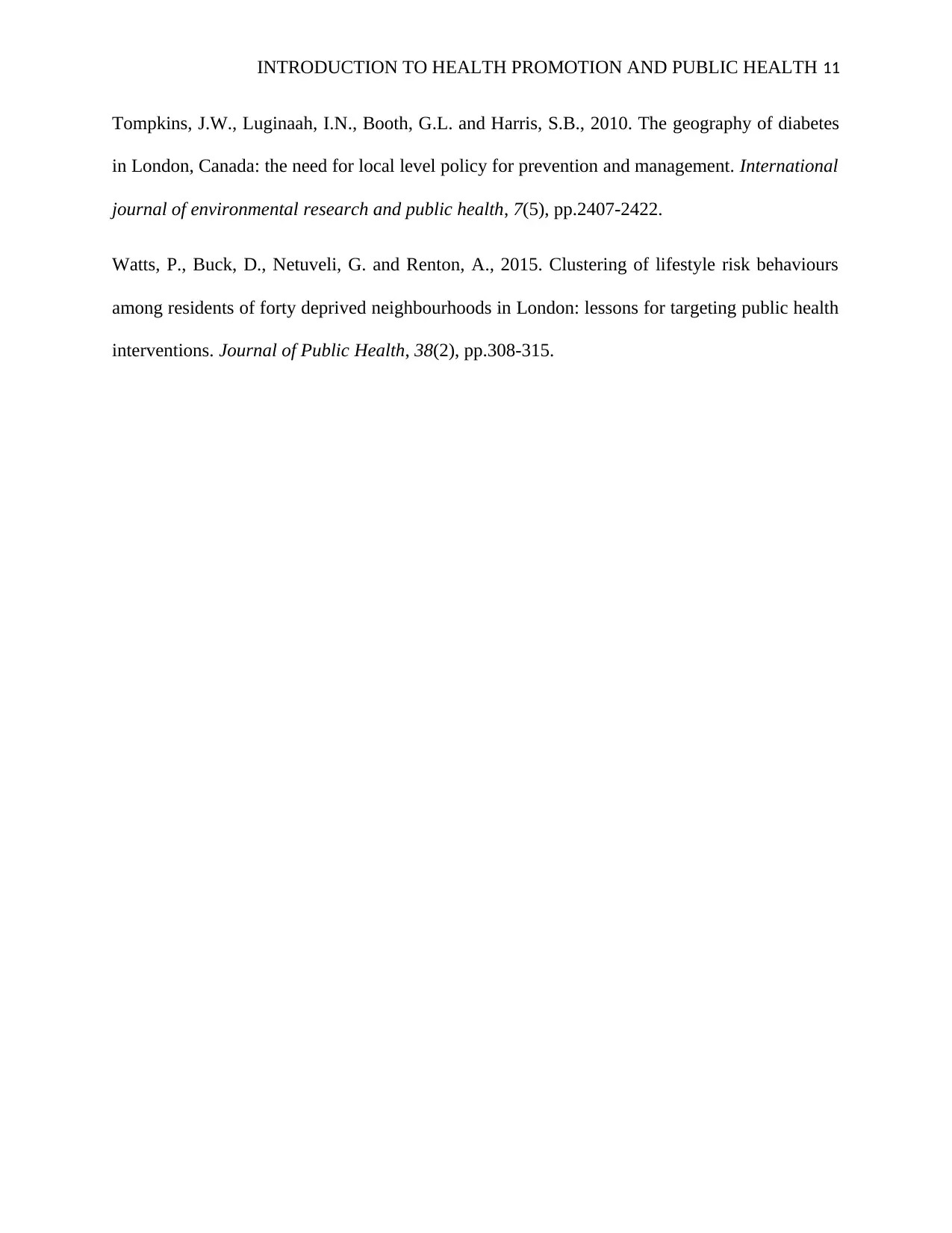
INTRODUCTION TO HEALTH PROMOTION AND PUBLIC HEALTH 11
Tompkins, J.W., Luginaah, I.N., Booth, G.L. and Harris, S.B., 2010. The geography of diabetes
in London, Canada: the need for local level policy for prevention and management. International
journal of environmental research and public health, 7(5), pp.2407-2422.
Watts, P., Buck, D., Netuveli, G. and Renton, A., 2015. Clustering of lifestyle risk behaviours
among residents of forty deprived neighbourhoods in London: lessons for targeting public health
interventions. Journal of Public Health, 38(2), pp.308-315.
Tompkins, J.W., Luginaah, I.N., Booth, G.L. and Harris, S.B., 2010. The geography of diabetes
in London, Canada: the need for local level policy for prevention and management. International
journal of environmental research and public health, 7(5), pp.2407-2422.
Watts, P., Buck, D., Netuveli, G. and Renton, A., 2015. Clustering of lifestyle risk behaviours
among residents of forty deprived neighbourhoods in London: lessons for targeting public health
interventions. Journal of Public Health, 38(2), pp.308-315.
1 out of 11
Related Documents
Your All-in-One AI-Powered Toolkit for Academic Success.
+13062052269
info@desklib.com
Available 24*7 on WhatsApp / Email
![[object Object]](/_next/static/media/star-bottom.7253800d.svg)
Unlock your academic potential
Copyright © 2020–2025 A2Z Services. All Rights Reserved. Developed and managed by ZUCOL.





